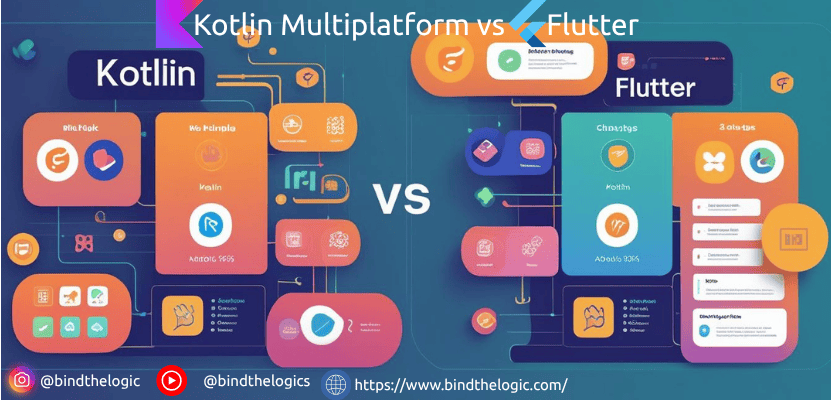Kotlin Multiplatform vs Flutter: Which Cross Platform Framework Should You Choose in 2025?
While both aim to reduce development time and effort by sharing code across platforms, they follow very different philosophies and technical approaches

In today’s rapidly evolving app development ecosystem, businesses and developers increasingly turn to cross-platform frameworks to build high-performance apps efficiently. Two strong contenders dominating the space are Kotlin Multiplatform (KMP) and Flutter. While both aim to reduce development time and effort by sharing code across platforms, they follow very different philosophies and technical approaches.
Let’s dive deep into a comparison between Kotlin Multiplatform and Flutter to help you choose the right tool for your next project.
Philosophy: Shared Logic vs Shared UI
Kotlin Multiplatform
- - Approach: Share business logic only.
- - UI: Built natively on each platform (Jetpack Compose on Android, SwiftUI/UIKit on iOS).
- - Goal: Maximize reuse of non-UI code such as networking, database, and business rules.
Flutter
- - Approach: Share both business logic and UI using the Dart language.
- - UI: Built with Flutter’s own rendering engine.
- - Goal: Write once, run anywhere, including web and desktop.
Language and Ecosystem
Kotlin Multiplatform
- - Uses Kotlin, a modern, expressive language officially supported by Google.
- - Leverages the mature JVM ecosystem and native libraries for iOS.
- - Fully interoperable with Java, Swift, and Objective-C.
Flutter
- - Uses Dart, which is easy to learn but not as widely adopted as Kotlin.
- - Has its own ecosystem, separate from native Android or iOS SDKs.
- - A fast-growing package manager (pub.dev) but still catching up with native SDK parity.
UI Development
Kotlin Multiplatform
- - Relies on native UI frameworks.
- - Offers KMP + Jetpack Compose Multiplatform (for Android/Desktop/Web) and SwiftUI/UIKit (for iOS).
- - Pros: Native look and feel, better performance.
- - Cons: UI code needs to be written separately for each platform (although Compose Multiplatform is bridging this gap).
Flutter
- - Provides a single codebase for the entire UI.
- - Uses widgets for everything — no reliance on native components.
- - Pros: Rapid prototyping, consistent UI across platforms.
- - Cons: Larger binary size, sometimes not “perfectly native” in look.
Performance
- Kotlin Multiplatform offers near-native performance since it compiles to JVM bytecode for Android and native binaries for iOS.
- Flutter also offers excellent performance via its Dart-based engine and ahead-of-time (AOT) compilation, though animations and complex UIs can sometimes feel less optimized on low-end devices.
Tooling & IDE Support
Kotlin Multiplatform
- - Excellent tooling with IntelliJ IDEA and Android Studio.
- - Debugging across platforms is steadily improving.
- - Builds on familiar tooling for Android developers.
Flutter
- - Excellent tooling with Flutter DevTools, hot reload, and seamless integration with Android Studio, VS Code, and IntelliJ.
- - Flutter’s development experience is known for being fast and developer-friendly.
Community and Support
- Flutter has a larger and more active community, more tutorials, and faster release cycles.
- Kotlin Multiplatform has strong backing from JetBrains and growing adoption, especially in enterprises looking to reuse business logic without sacrificing native UIs.
Platform Coverage
| Feature | Kotlin Multiplatform | Flutter |
|---|---|---|
| Android | ✅ Native | ✅ Full support |
| iOS | ✅ Native | ✅ Full support |
| Web | ✅ (Experimental via Compose) | ✅ Full support |
| Desktop (Windows/mac) | ✅ (Experimental/Stable) | ✅ Stable |
| Embedded Devices | ❌ Limited | ✅ via Flutter Embedded |
Use Cases
Choose Kotlin Multiplatform if:
- - You already have native teams and want to share logic but keep native UI.
- - You are building complex apps with deep platform integration.
- - You need to interoperate with existing Kotlin/Java or Swift codebases.
Choose Flutter if:
- - You want a single team to build for all platforms quickly.
- - UI/UX consistency across devices is a high priority.
- - You’re building MVPs, startups, or prototypes with limited resources.
Final Verdict
| Criteria | Kotlin Multiplatform | Flutter |
|---|---|---|
| Learning Curve | Medium (for native devs) | Easy |
| Code Reuse | High (logic only) | Very High (UI + logic) |
| UI Performance | Native | Near-native |
| Community | Growing | Large & Active |
| Maturity | Production-ready (2025) | Very Mature |
Future Outlook
Both frameworks are evolving rapidly. Kotlin Multiplatform is being increasingly adopted in large-scale projects (like Netflix, Philips, and VMware), while Flutter continues to dominate the startup and prototyping world with its fast UI capabilities and expanding ecosystem.
In 2025 and beyond, the decision comes down to your team’s skill set, the complexity of the UI, and how much native feel you require.